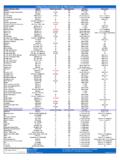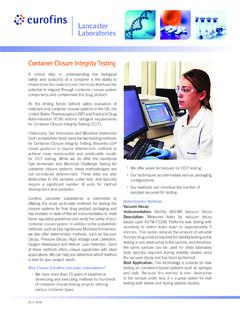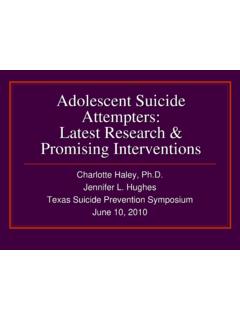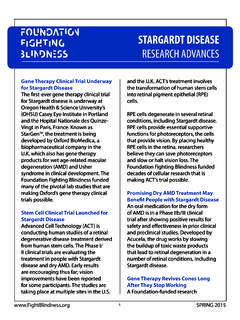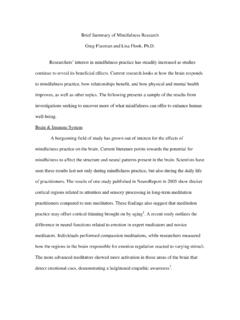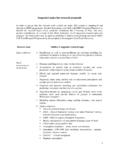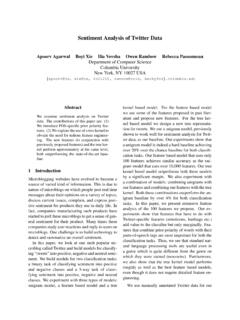Transcription of The Latest Research on Grapevine Virology - eurofinsus.com
1 56 June 2013 WBMgrape growingThe Latest Research on Grapevine Virology Highlights from the 17th Meeting of the International Council for the Study of Virus and Virus-Like Diseases of the GrapevineJudit Monis and Nuredin HabiliTHE Latest Research ON Grapevine Virology was presented at the 17th annual meeting of the International Council for the Study of Virus and Virus-Like Diseases of the Grapevine (ICVG). The meeting, held every three years to promote collaboration and interaction among Grapevine pathologists who specialize in viruses, viroids and phytoplasmas, took place in October 2012 in Davis, California and was well attended, with more than 120 scientific presentations representing different grape-growing areas around the world.
2 Two field visits were organized to learn about local disease problems, planting selections and disease prevention. The delegates visited the UC Davis Foundation Plant Services laboratory and foundation blocks, as well as the USDA ARS Germplasm Repository vineyards in Davis and Vacaville, respectively, where they heard presentations on breeding, clonal selection and California clean stock programs. As it has been a tradition for many years, Giovanni Martelli, chairman of the ICVG, presented the introductory keynote talk with an overview of the progress in Grapevine virus Research in the past three years. There were nine main sessions presented at the ICVG in which a broad range of Research was presented.
3 Highlights are summarized below. Fanleaf and Other Spherical Nematode-transmitted VirusesThis session opened with an overview of fanleaf and other spherical viruses by Dr. Marc Fuchs of Cornell University, who discussed the transient expres-sion of antiviral constructs (segments of genes) that interfere with Grapevine fanleaf virus (GFLV) multiplication. The Research promises to speed up the use of genetically engineered resistance to this virus in grapevines. Based on the transient work, Grapevine rootstock varieties, transformed with the most efficient antiviral constructs, are being evaluated in a naturally infected Disease and Related VirusesA study in France on the natural transmission of Grapevine leafroll disease highlighted the risk of establishing new vineyards adjacent to diseased ones.
4 Two Pinot Noir vineyards in Burgundy were surveyed for a period of eight years. One of the vineyards planted with certified plant material displayed typical leafroll symptoms that appeared to spread rapidly from the edges of the vineyard to the entire block. Further analyses demonstrated that the virus and its vectors originated from the adjacent GLRaV-1 infected blocks, which were also heavily infested by mealy bugs (Phenacoccus aceris). The second vineyard displayed none or very little incidence of leafroll disease. This vineyard was not surrounded by mealy bug-infested or leafroll-infected vineyards. The researchers noted that Grapevine Virus A (GVA) and B (GVB), often found in combination with GLRaVs, are transmitted by the same mealy bugs and scale insects.
5 Another study in France reported the dispersal of Parthenolecanium corni, the vector of GLRaV-1 and GVA, in a vineyard surrounded by infected grapes. Their healthy trial block was set among infected vines, and the results showed that the healthy vines were rapidly infected by the virus. The results support those reported for GLRaV-3 from New Zealand in 2009, in which healthy vines were planted several years later in a fallow block after removal of a leafroll-infected vineyard. All the new vines were infected due to the survival of mealy bug vectors on root remnants. Judit Monis is the plant health services division manager at Eurofins STA Labs.
6 The lab provides state-of-the art disease testing and consulting, specializing in Grapevine clean planting stock and vineyard disease management. Please direct queries to or Habili is a senior scientist at Waite Diagnostics, School of Agriculture, Food & Wine, The University of Adelaide, Australia. The lab provides advanced DNA testing for virus and phytoplasma in samples of grapevines and coconuts sent from growers, as well as famous institutes around the world. Please direct queries to or + (61) 88313-7426. WBM June 2013 57In another study, the transmission of GVA was found to be negligible in the absence of a leafroll (helper) virus. When Planococcus ficus mealy bugs fed on Chardonnay vines doubly infected with GLRaV-3 and GVA, the mealy bugs transmitted both viruses to healthy Pinot Noir plants in a higher proportion (31 percent) than either GLRaV-3 (24 percent) or GVA (2 percent) alone.
7 Preliminary results of a long-term study on the effects of GLRaV on yield, vine performance and grape quality in California were presented. Cabernet Franc vines budded onto nine different rootstocks were inoculated with different GLRaVs and planted in the field to monitor the symptoms, plant growth, yield and berry qualities. The data collected in 2011 showed that the mixed infection of GLRaV-1 and GVA had detrimental effects on Cabernet Franc plants propagated on 420A, Freedom, 3309C and 101-14 rootstocks many of these vines died within a few months after inoculation. In addition, GLRaV-2 positive vines grafted on Freedom and 5BB were extremely weak, showing red leaves and short internodes.
8 This study will provide further information on the severe damage of a combination of different leafroll viruses on vine and wine Africa has pioneered the control of GLRaV-3 infections in red vari-eties with vine removal, insect control and planting disease-free vines. This strategy is more difficult to apply in vineyards with infected white varieties. Because symptoms are less obvious, the confirmation of virus infection relies on laboratory diagnosis before vine removal. The molecular diversity of Pacific Northwest GLRaV-2 field isolate, from own-rooted, asymptomatic Sangiovese Grapevine (designated as GLRaV-2-Sg), was determined to be closely related to the isolate from Oregon and South Africa but distantly related to the variants known to cause graft incompatibility, such as the Red Globe or RG isolate from USA and BD isolate from Italy.
9 It was noted that asymptomatic strains can induce disease in other situations ( , after being grafted), signaling the importance of rigorous testing in clean plant programs to ensure that elite virus-tested propagating materials are provided to nurseries and grape WOODNATURALLYSEASONEDT hink Cooperage at its Best!JUDIT MONISC lose up view of a Grapevine accession at the USDA ARS Repository Germplasm collection note the disease symptoms related to leafroll 2013 WBMThe Latest Research on Grapevine Virology Rugose Wood and Related VirusesA study by Gambino, et al. suggests that the long co-existence between grape and Grapevine Rupestris Stem Pitting-associated Virus (GRSPaV) resulted in a favorable mutual adaptation between this virus and its host, which led to the lack of disease development in grapevines.
10 The absence of symptoms in many own-rooted Australian varieties singly infected with GRSPaV has been observed for many years (N. Habili, unpublished). The analysis of several American and European Grapevine accessions never subjected to grafting suggests that an ancestor of GRSPaV infected the Vitis species a long time ago since it is found both in cultivated (Vitis vinifera ssp. vinifera) and wild (V. vinifera ssp. sylvestris) grapevines. It is interesting to note that GRSPaV was not detected in a number of vineyards in the Old World, providing evidence that the virus has an American origin and entered Europe in the 19th Century via infected American rootstock hybrids.
